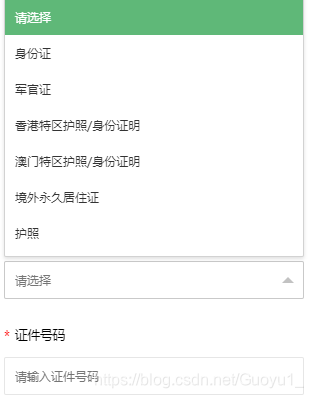js根据不同证件进行校验
本文共 1575 字,大约阅读时间需要 5 分钟。
layui下拉
layui.use(['form','element'], function(){ var form = layui.form ,layer = layui.layer ,id_type;//监听下拉当前选择的 form.on('select(idsType)',function (data) { id_type=data.value }) form.on('submit(demo1)', function(data){ let idVal=$("input[name='idNumber']").val(); let reg; if(id_type==0){ console.log('身份证',id_type) reg = /(^\d{15}$)|(^\d{17}(\d|X|x)$)/; if(!reg.test(idVal)){ layer.msg('证件信息错误', {time: 4000, icon:5}); return false; } }else if(id_type==1){ console.log('军官证',id_type) reg = /^[a-zA-Z0-9]{7,21}$/; if(!reg.test(idVal)){ layer.msg('证件信息错误', {time: 4000, icon:5}); return false; } }else if(id_type==2){ console.log('香港特区护照/身份证明',id_type) reg = /^[a-zA-Z0-9]{5,21}$/; if(!reg.test(idVal)){ layer.msg('证件信息错误', {time: 4000, icon:5}); return false; } }else if(id_type==3){ console.log('澳门特区护照/身份证明',id_type) reg = /^[a-zA-Z0-9]{5,21}$/; if(!reg.test(idVal)){ layer.msg('证件信息错误', {time: 4000, icon:5}); return false; } }else if(id_type==4){ console.log('境外永久居住证',id_type) reg = /^[A-Z]{3}\d{6}(?:0[1-9]|1[021])(?:0[1-9]|[21]\d|3[10])\d{2}$/; if(!reg.test(idVal)){ layer.msg('证件信息错误', {time: 4000, icon:5}); return false; } }else if(id_type==5){ console.log('护照',id_type) reg = /^[a-zA-Z0-9]{3,21}$/; if(!reg.test(idVal)){ layer.msg('证件信息错误', {time: 4000, icon:5}); return false; } }}}) 
转载地址:http://nwkj.baihongyu.com/
你可能感兴趣的文章
nacos集群搭建
查看>>
nagios安装文档
查看>>
name_save matlab
查看>>
Nami 项目使用教程
查看>>
NAT-DDNS内网穿透技术,解决动态域名解析难题
查看>>
NativePHP:使用PHP构建跨平台桌面应用的新框架
查看>>
NAT技术
查看>>
NAT模式下虚拟机centOs和主机ping不通解决方法
查看>>
NAT的两种模式SNAT和DNAT,到底有啥区别?
查看>>
Navicat for MySQL 命令列 执行SQL语句 历史日志
查看>>
Navicat for MySQL 查看BLOB字段内容
查看>>
Navicat Premium 12 卸载和注册表的删除
查看>>
navicat 系列软件一点击菜单栏就闪退
查看>>
navicat 连接远程mysql
查看>>
Navicat下载和破解以及使用
查看>>
navicat创建连接 2002-can‘t connect to server on localhost(10061)且mysql服务已启动问题
查看>>
Navicat可视化界面导入SQL文件生成数据库表
查看>>
Neat Stuff to Do in List Controls Using Custom Draw
查看>>
NeHe OpenGL教程 第四十四课:3D光晕
查看>>
neo4j图形数据库Java应用
查看>>